Your post-workout recovery can accelerate dramatically through targeted cellular therapy strategies. Start with a proper cool-down and immediate nutrition featuring a 3:1 carb-to-protein ratio within 30 minutes. Incorporate red light therapy to boost mitochondrial function and ATP production, while compression garments help reduce inflammation and muscle soreness. Don't skip your 7-9 hours of sleep, as it's essential for cellular repair. Combine these with contrast water therapy at 50-59°F to minimize delayed onset muscle soreness. Understanding these cellular-level interventions will release your body's full recovery potential.
Understanding Cellular Recovery Fundamentals
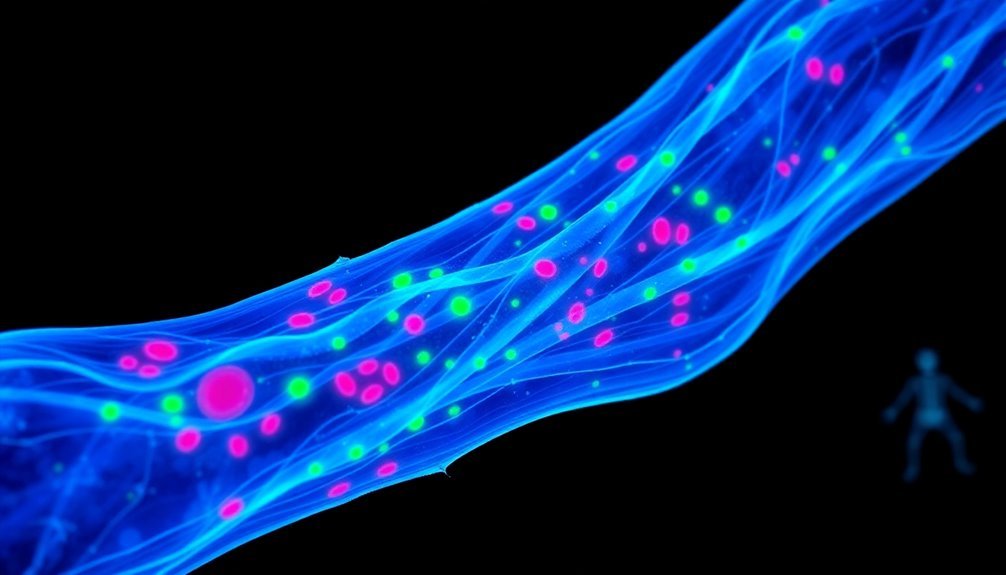
Breaking down cellular recovery reveals a complex interplay between inflammation, membrane integrity, and energy production. When you exercise, your cells experience stress that can trigger inflammasomes and lead to chronic inflammation if not properly managed.
This cellular damage extends to your mitochondria, the powerhouses responsible for producing ATP, and can markedly impact your performance and recovery.
Your cellular membranes are particularly vulnerable during intense workouts, with both mitochondrial and cellular lipids suffering degradation. This damage directly affects your energy production capacity and overall cell function. Natural phospholipid replacement strategies can help restore damaged membrane structures and improve cellular function.
You'll notice decreased performance and slower recovery times when these cellular components aren't operating at their peak.
Understanding the role of ATP is pivotal, as it's the primary energy currency your cells need for recovery and performance. Your mitochondrial health directly influences how efficiently you can produce this essential compound.
When chronic inflammation and oxidative stress persist, they create a cycle that impairs your muscle recovery process. That's why it's vital to address recovery at the cellular level, focusing on membrane repair, inflammation control, and energy production optimization to maintain peak athletic performance.
Red Light Therapy Mechanisms
Red light therapy's specific wavelengths (630-680 nm and 800-940 nm) penetrate your skin to trigger cellular healing and enhanced mitochondrial function.
You'll experience faster recovery as these wavelengths boost ATP production and reduce inflammation in your muscle tissue.
Your body responds to this targeted light therapy by increasing blood flow and oxygen transport, which accelerates the natural healing process after intense workouts. This non-invasive treatment provides drug-free recovery while supporting optimal cellular regeneration.
Wavelength Benefits For Recovery
Through extensive scientific research, red light therapy (RLT) has emerged as a powerful tool for post-workout recovery, operating through multiple biological mechanisms. When you expose your muscles to specific wavelengths of red light, you'll trigger a cascade of cellular responses that enhance your recovery process.
These wavelengths penetrate your tissue and stimulate your mitochondria, boosting ATP production – your cells' primary energy source. This increased cellular energy accelerates muscle repair and reduces recovery time. Regular evening sessions can help regulate sleep patterns, promoting better rest and recovery quality.
You'll experience enhanced blood flow as the light stimulates nitric oxide production, which dilates your blood vessels and delivers more oxygen and nutrients to recovering muscles.
The therapeutic wavelengths also work to decrease inflammation and oxidative stress in your muscle tissue. You'll notice reduced muscle soreness and pain as RLT modulates inflammatory markers and helps prevent delayed onset muscle soreness (DOMS).
This anti-inflammatory effect, combined with improved circulation, creates ideal conditions for muscle regeneration.
For athletic performance, these wavelength benefits translate into improved muscle endurance, faster recovery between training sessions, and enhanced overall performance capacity. Your muscles will repair more efficiently, allowing you to maintain consistent training intensity.
Light Penetration And Healing
When exposing your body to red light therapy, specific wavelengths penetrate your tissues at varying depths to activate multiple healing mechanisms simultaneously.
As the light reaches your cells, it triggers increased ATP production in your mitochondria, providing more energy for cellular repair and regeneration.
The penetrating light stimulates blood flow and oxygenation throughout your treated tissues. You'll experience enhanced circulation, which helps deliver essential nutrients while removing waste products from recovering muscles. The therapy can increase cell growth by 140-200% in fibroblasts.
This improved blood flow also promotes the formation of new blood vessels, supporting long-term healing capacity.
At the cellular level, you'll benefit from accelerated repair processes as the light energy stimulates fibroblast activity and collagen production. Your cells will regenerate faster, while increased collagen synthesis strengthens recovering tissues.
The light therapy also triggers important immune responses, activating neutrophils, monocytes, and lymphocytes to combat inflammation.
These healing mechanisms work together to reduce post-workout inflammation and pain. Your body's enhanced nitric oxide release further supports blood flow and inflammation reduction, while the stimulated enzymatic and chemical processes help speed up your recovery time.
Muscle Repair Science
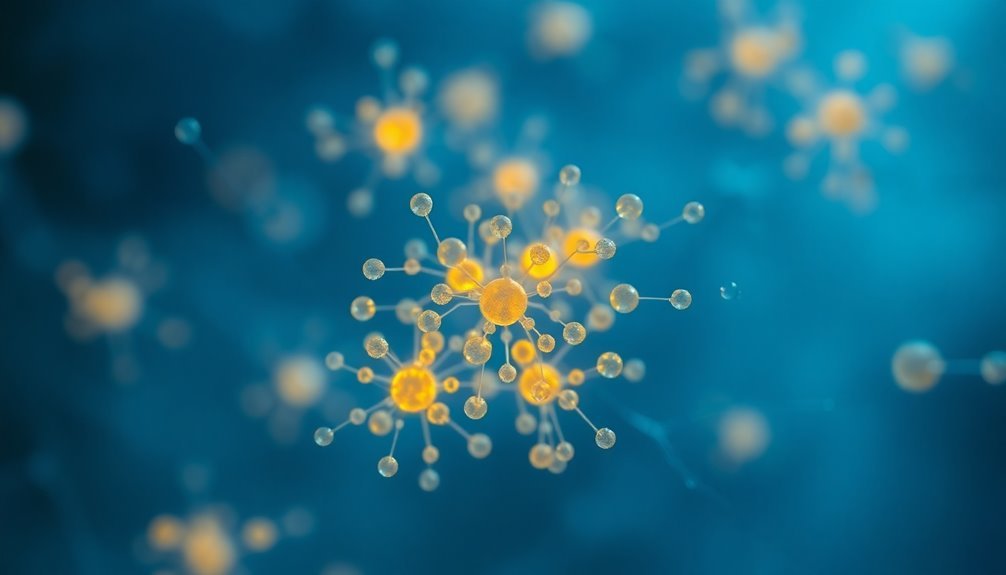
Inside the complex world of muscle repair science, cellular therapy has emerged as a groundbreaking approach to healing and recovery. When you exercise intensely, your muscle tissues experience damage that requires efficient repair mechanisms to rebuild stronger and prevent injury.
Your body's resident muscle stem cells play a vital role in this regeneration process. These specialized cells can activate and multiply to repair damaged tissue, and scientists have discovered that specific drug cocktails can enhance their expansion for therapeutic purposes. Cyclic loading helps guide the development of healing cells into proper tissue formation.
Through advanced delivery systems like nanoparticles, these treatments can be precisely targeted to affected areas.
You'll find that cellular therapy leverages various components, including stem cells from bone marrow and platelet-rich plasma, to accelerate healing and reduce inflammation. Modern imaging techniques and predictive tools now help identify which cells will perform best for your treatment, making the process more efficient and reliable.
While supplements like protein and magnesium support recovery, cellular therapy offers a more direct approach to muscle repair. The combination of targeted drug delivery, stem cell activation, and precise cell selection creates a powerful framework for enhanced post-workout recovery and injury treatment.
Optimizing Recovery Windows
To maximize your cellular therapy's effectiveness, you'll need to target specific post-workout windows when your muscles are most receptive to treatment.
Your strategic approach should align the therapy with your body's natural recovery phases, typically within the first 24-48 hours after intense exercise when protein synthesis and cellular repair mechanisms are heightened.
Similar to how the closed system environment helps maintain optimal conditions in clinical cell processing, you can further enhance these benefits by implementing treatments in phases that match your workout intensity, with more intensive cellular therapies scheduled after your most demanding training sessions.
Timing Cell Treatment Windows
Successful cellular therapy recovery depends heavily on precise timing and careful activity management throughout distinct phases.
During your first four weeks post-treatment, you'll need to balance rest with gentle movement, focusing on low-impact activities like stationary biking and swimming once your incisions heal. Your doctor may recommend starting physical therapy within 4-6 days after the procedure.
You'll want to incorporate gentle myofascial release and light stretching while avoiding ultrasound and electrical stimulation treatments.
As you move into weeks 5-8, you can gradually increase your activity level but should still avoid compression exercises and heavy loads. Stick to no-impact exercises like pool jogging and elliptical training to support ideal cell development.
Remember, you'll need to skip anti-inflammatory medications for at least six weeks post-treatment.
The 3-6 month window is vital, as your stem cells reach peak potency during this period. You can safely begin aerobic exercises, but you'll need to carefully monitor your treatment area for any pain signals.
Throughout your recovery, you'll benefit from using kinesiology tape and heat/ice treatments for pain management while maintaining regular communication with your healthcare team to adjust your recovery plan as needed.
Strategic Post-Exercise Recovery
While cellular therapy requires careful long-term planning, optimizing your immediate post-exercise recovery windows can enhance treatment outcomes. You'll need to focus on two critical windows: the first 30 minutes post-workout and the 1-3 hour period that follows.
In the initial 30-minute window, you'll want to consume 100-300 calories with a 3:1 or 4:1 ratio of carbohydrates to protein. This combination helps jumpstart glycogen replenishment and supports muscle repair. Consuming electrolyte-rich foods like crackers, peanuts, and soups can help replace vital minerals lost during exercise.
During the second window, shift your focus to higher protein intake along with healthy fats and complex carbohydrates.
Don't neglect active recovery techniques during these windows. Incorporate gentle stretching or slow walking to maintain blood flow, and consider using compression garments to reduce muscle soreness.
You'll also benefit from foam rolling or massage to enhance circulation and reduce muscle tension.
Remember to monitor your glucose levels using CGM if available, as this can help you fine-tune your nutritional timing. Stay well-hydrated and prioritize quality sleep to maximize recovery benefits.
These strategic approaches work synergistically with cellular therapy to optimize your body's repair processes.
Optimal Treatment Implementation Phases
Every successful cellular therapy program follows distinct implementation phases that align with your post-workout recovery windows. You'll progress through carefully designed stages that maximize your body's natural healing response while safeguarding safety and effectiveness.
| Phase | What You'll Experience |
|---|---|
| Initial Assessment | You'll undergo thorough testing to determine your baseline cellular health and recovery needs |
| Treatment Preparation | Your cells will be isolated and processed using specialized techniques optimized for athletic recovery |
| Active Implementation | You'll receive strategically timed cellular treatments that sync with your training schedule |
| Monitoring & Adjustment | Your progress will be tracked through specific biomarkers and performance metrics |
During the research phase, you'll benefit from proven protocols that have undergone rigorous testing. The preclinical evaluation safeguards you're receiving treatment that's both safe and effective for athletic recovery. As you move into the clinical phase, you'll experience carefully scaled treatments that match your body's recovery windows. Throughout the process, you'll be supported by quality-controlled manufacturing processes that maintain the highest standards of cellular therapy production. Each phase builds upon the previous one, creating a detailed recovery strategy that's tailored to your athletic needs.
Cellular Therapy Safety Protocols
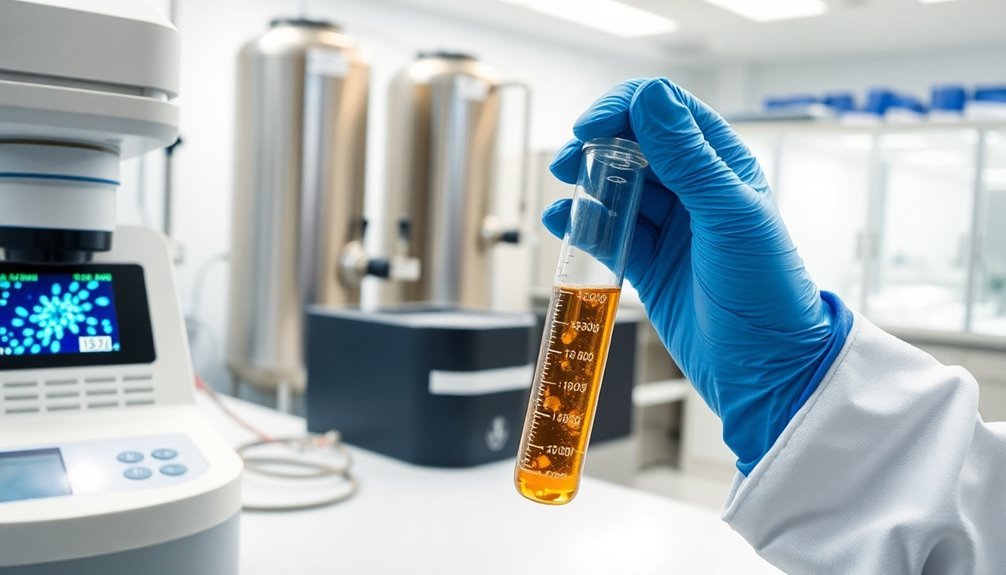
The safety protocols for cellular therapy encompass three vital components: thorough donor screening, rigorous safety testing, and ongoing risk management. Before you undergo cellular therapy for post-workout recovery, it's critical to understand that these protocols protect you from potential transmission of infectious agents, including bacteria, viruses, and fungi.
Your healthcare provider must follow strict FDA guidelines for cell safety testing, which includes screening for adventitious agents and monitoring the materials used in the manufacturing process. They'll also assess the potential risks of immunizing substances that may be present in the cellular therapy products.
You'll undergo extensive pre-treatment screening to identify any potential allergic reactions or complications.
Your treatment will be monitored for signs of Cytokine Release Syndrome (CRS), which can cause fever and breathing difficulties.
You'll receive regular blood tests to check for mineral imbalances and immune system function.
Your provider will maintain detailed documentation of all safety protocols and testing results.
Remember that while cellular therapy offers promising benefits for post-workout recovery, it's essential to work with qualified providers who strictly adhere to these safety protocols to minimize potential risks and guarantee effective treatment outcomes.
Post-Exercise Treatment Timing
When you're considering cellular therapy for post-workout recovery, timing is absolutely critical, as treatments within the first 15-60 minutes after exercise show the most beneficial effects on muscle recovery and damage control.
You'll get the best results during this "recovery window sweet spot" when neutrophil infiltration and muscle cell lysis are actively occurring, making it easier for cellular therapies to target and support healing processes.
If you can't receive treatment immediately, same-day applications still offer advantages over delayed treatments, though their effectiveness may decrease as the pro-inflammatory response intensifies over subsequent hours.
Immediate Vs Delayed Treatment
Starting your recovery protocol at the right time can substantially impact its effectiveness. Your body's response to exercise triggers different recovery processes at various time points, making both immediate and delayed treatments essential for best results.
While immediate post-exercise recovery within the first 10 minutes helps prevent blood pooling and enhances circulation, delayed treatment addresses the peak muscle soreness that typically occurs 24-48 hours after your workout.
Immediate treatment (within 10 minutes):
Start with a proper 5-10 minute cool-down matching your workout type, use foam rolling techniques, and apply compression gear to enhance blood flow and initiate recovery processes.
Short-term recovery (first hour):
Focus on hydration, nutrition, and choose between active or passive recovery based on your fatigue level.
Peak recovery window (24-48 hours):
Address DOMS through massage, compression garments, or contrast water therapy when muscle soreness is at its highest.
Long-term considerations:
Balance your recovery techniques to support muscle protein synthesis and prevent overtraining, while maintaining consistency in your recovery routine for effective adaptation.
Recovery Window Sweet Spot
During the critical post-exercise period, identifying the ideal recovery window can maximize your treatment's effectiveness. Research shows that the first hour post-workout offers the most significant opportunity for cellular recovery interventions, as this period experiences intense physiological changes including neutrophil infiltration and muscle cell lysis.
You'll want to capitalize on the first 4 hours after exercise, when your body's recovery mechanisms are most active. Start with a 5-10 minute cool-down to normalize your heart rate and improve circulation, then implement your recovery protocol within the first 60 minutes.
This includes consuming protein and carbohydrates within 30-60 minutes and applying any temperature therapy, particularly cryotherapy, within the first hour.
If you're undergoing cellular therapy, you'll need to extend your recovery window considerably. Plan for 7-9 days of hospital management, followed by 28 days of local monitoring.
Your recovery protocol should combine both immediate and delayed strategies, adjusting based on your training intensity and overall stress levels. Remember to hydrate adequately by consuming 150% of lost weight within 4 hours post-exercise, and maintain consistent monitoring of your recovery markers.
Same-Day Application Benefits
In accordance with research on post-exercise recovery, implementing same-day treatments offers significant advantages for muscle repair and regeneration. When you apply recovery techniques immediately after your workout, you'll enhance the healing process and minimize potential tissue damage.
Red light therapy, in particular, has shown promising results when used right after exercise, helping to reduce inflammation and accelerate muscle recovery.
Immediate Inflammation Control
By starting treatment within hours of your workout, you'll effectively manage the inflammatory response and prevent excessive tissue breakdown.
Enhanced Muscle Repair
Same-day intervention with techniques like massage and light movement activates cellular repair mechanisms more efficiently.
Reduced Recovery Time
Swift application of therapeutic tools can cut down your recovery window, getting you back to training sooner.
Better Range of Motion
Early treatment helps maintain joint mobility and reduces muscle stiffness.
Timing is vital when it comes to post-exercise recovery strategies. By avoiding anti-inflammatory medications and instead focusing on natural healing methods like red light therapy and gentle movement, you'll support your body's regenerative processes.
Remember to maintain open communication with your healthcare provider to confirm your recovery protocol aligns with your individual needs.
Light Wavelength Benefits
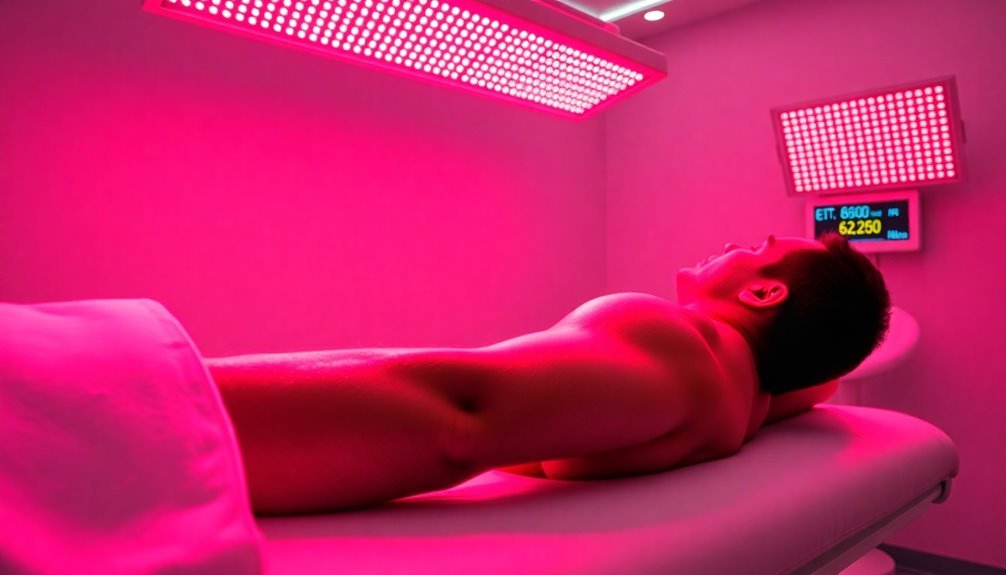
Light therapy has emerged as a game-changing recovery method, with specific wavelengths offering unique benefits for post-workout healing. When you're looking to optimize your recovery, understanding these wavelengths can help you target specific needs.
Red light (630-700 nm) works at the cellular level by boosting your ATP production and enhancing mitochondrial function. You'll experience improved circulation, reduced muscle soreness, and decreased oxidative stress.
This wavelength particularly benefits your skin and superficial muscle tissue, making it ideal for surface-level recovery.
Near-infrared light (700-1200 nm) penetrates deeper into your tissues, making it extremely effective for joint and deep muscle recovery. You'll notice reduced inflammation, decreased pain, and accelerated healing in areas that red light can't reach effectively.
Inflammation Control Methods
Managing post-workout inflammation effectively requires a multi-faceted approach that combines cellular therapies, exercise protocols, and targeted interventions. You'll find that mesenchymal stem cells (MSCs) and their exosomes play a vital role in modulating inflammatory responses, while specific exercise patterns can enhance your body's natural recovery mechanisms.
- MSCs-derived exosomes reduce inflammation and support tissue repair by interacting with immune cells, making them particularly effective for treating exercise-induced muscle stress.
- High-intensity interval training (HIIT) triggers an acute inflammatory response that actually helps your body adapt and repair, with studies showing up to 87% decrease in inflammatory markers post-exercise.
- Cellular therapies like CAR-T and Treg cells can regulate immune responses, potentially offering long-term solutions for chronic inflammation management.
- Timing matters – avoid taking anti-inflammatory medications like ibuprofen before workouts, as they can blunt the beneficial inflammatory responses that drive adaptation.
Your recovery strategy should combine these approaches strategically. While HIIT provides immediate benefits, cellular therapies offer sustained inflammation control, and proper timing of interventions guarantees optimal results.
Tissue Regeneration Principles
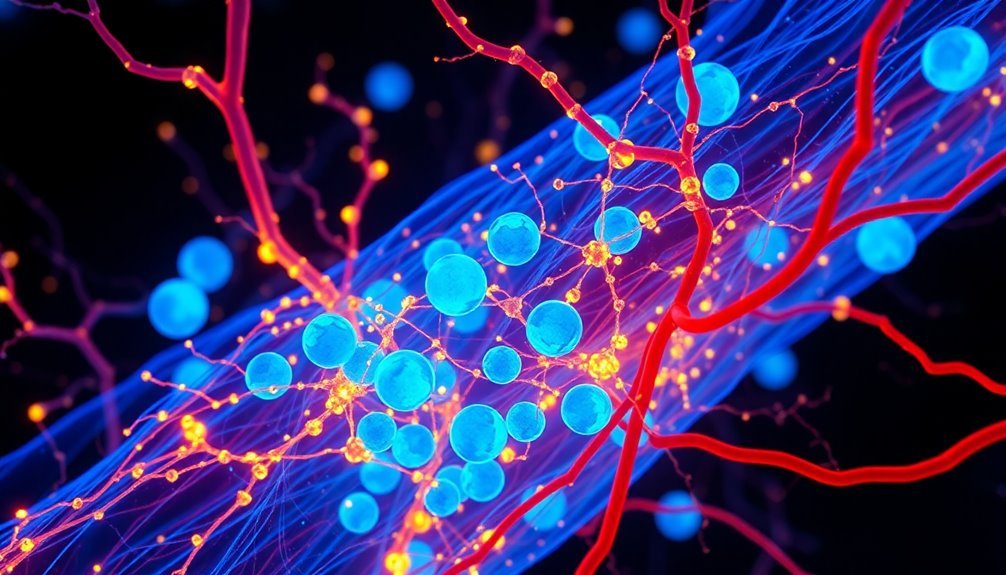
While your body naturally possesses remarkable healing abilities, understanding tissue regeneration principles can help you optimize your post-workout recovery process. Your cells work together in a complex symphony of repair, with keratinocytes and immune cells orchestrating the healing response. You'll benefit from knowing that your body's repair mechanisms rely heavily on cellular movement and matrix remodeling.
| Cell Type | Function | Recovery Impact |
|---|---|---|
| Stem Cells | Differentiate into needed tissue types | Speeds up tissue repair |
| Immune Cells | Clean up damage and guide healing | Reduces inflammation |
| Keratinocytes | Enable wound closure and healing | Promotes skin recovery |
| Progenitor Cells | Generate specific tissue types | Supports muscle repair |
You're equipped with multiple cellular repair systems that activate after intense workouts. These include resident stem cells that can transform into various tissue types and specialized cells that release growth factors. When you're recovering, your body's matrix metalloproteases (MMPs) actively remodel damaged tissue while desmosomal junctions become more flexible to allow cellular migration. Understanding these principles helps you make informed decisions about recovery timing and methods, ensuring you don't interfere with your body's natural regenerative processes.
Performance Enhancement Strategies
A strategic approach to cellular therapy can revolutionize your athletic performance and recovery outcomes. By harnessing the power of stem cells, you'll accelerate tissue repair while optimizing your body's natural healing capabilities. This advanced treatment doesn't just address current injuries – it's designed to enhance your overall athletic potential and prevent future setbacks.
- You'll experience faster recovery times between training sessions, allowing you to maintain peak performance levels and reduce unwanted downtime.
- Your joints will benefit from improved flexibility and mobility, while cartilage regeneration helps protect against wear and tear.
- You'll notice enhanced muscle strength and endurance, coupled with increased energy levels for better athletic performance.
- Your body will develop stronger resistance to injuries through preemptive treatment and tissue optimization.
When you integrate cellular therapy into your training regimen, you're not just treating injuries – you're investing in a thorough performance enhancement strategy.
The non-surgical nature of these treatments means you can maintain your training schedule while experiencing the benefits of advanced regenerative medicine.
You'll find your body responds more efficiently to training stimuli, helping you reach and maintain your peak performance goals.
Recovery Integration Guidelines
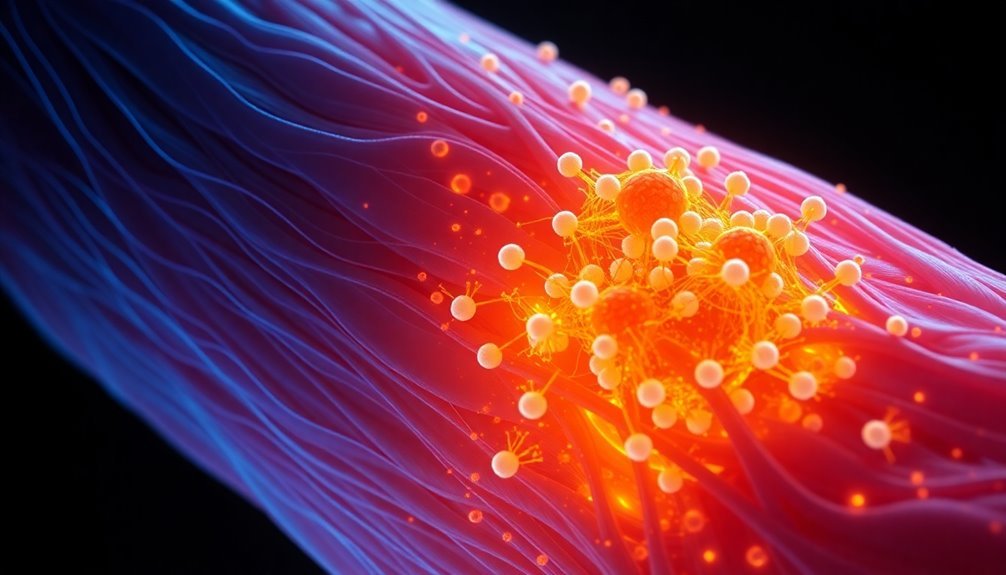
Successful cellular therapy requires a methodical approach to recovery integration. You'll need to follow specific guidelines immediately after treatment, avoiding anti-inflammatory medications while using ice to manage swelling.
Follow your doctor's instructions carefully and use kinesiology tape when recommended for pain management.
In the early stages, focus on no-load exercises like gentle walks and pool jogging to maintain mobility without straining the treated area. You'll want to avoid high-impact activities completely while incorporating gentle stretching through modified Pilates or yoga sessions.
As you progress to mid-stage recovery, you can begin light resistance training, but steer clear of exercises that create compression on the healing tissues.
For long-term success, maintain a consistent routine of gentle exercises like walking and biking. If you're not seeing significant improvement after three months, you might need to discuss PRP booster options with your healthcare provider.
Keep the communication lines open with your medical team and adjust your recovery plan as needed. Remember to protect the healing tissues from unnecessary stress while maintaining a balanced approach to activity and rest.
Long-Term Healing Effects
Research breakthroughs in cellular therapy have revealed promising long-term healing effects for post-workout recovery. The versatility of multipotent stem cells allows them to differentiate into various cell types, directly impacting your body's natural healing processes.
Studies show that 87.5% of patients experience sustained improvement within three months of treatment, suggesting similar benefits for athletes seeking enhanced recovery.
- You'll notice measurable improvements in tissue repair and joint function within 3-6 months post-treatment, with success rates reaching up to 80% for joint-related applications.
- Your immune system will strengthen progressively over time, helping prevent future exercise-related injuries and reducing inflammation.
- You can expect sustained benefits in muscle recovery and repair, with clinical trials showing lasting improvements in tissue regeneration.
- Your overall quality of life will improve within weeks of treatment, particularly in areas of mobility and reduced post-workout pain.
To maximize these healing effects, you'll need to maintain a healthy diet and follow proper post-treatment protocols.
The clinical evidence supports cellular therapy's role in optimizing long-term athletic performance and recovery, though specific results may vary based on individual factors and treatment protocols.
Frequently Asked Questions
How Much Does Cellular Therapy Typically Cost for Athletic Recovery?
You'll typically spend $4,000 for a single stem cell injection, with additional injections costing around $800 each. Total treatment costs can range from $5,000 to $10,000 depending on your location and needs.
Can Cellular Therapy Be Combined With Cryotherapy or Ice Baths?
Yes, you can combine cellular therapy with cryotherapy or ice baths. This combination may enhance your recovery by reducing inflammation while supporting cellular repair, though timing and proper protocol are essential for best results.
Are There Specific Dietary Restrictions Before Receiving Cellular Therapy Treatment?
You'll need to avoid raw or undercooked foods, unpasteurized products, and restaurant meals before cellular therapy. Stick to well-cooked meats, pasteurized dairy, and properly handled foods to prevent infection risks.
How Many Cellular Therapy Sessions Are Needed for Optimal Athletic Results?
You'll need a personalized treatment plan since there's no standard protocol. Your injury type, health status, and response to therapy will determine the number of sessions needed for peak athletic results.
Do Insurance Companies Typically Cover Cellular Therapy for Sports Recovery?
You won't typically find insurance coverage for cellular therapy in sports recovery. Most providers consider it experimental and won't cover it, so you'll need to pay out-of-pocket or explore financing options.
In Summary
You've now got the blueprint for accelerating your post-workout recovery through cellular therapy. By combining red light therapy, strategic timing, and proper safety protocols, you'll maximize your body's natural healing processes. Remember to integrate these techniques gradually into your routine and monitor your progress. You're equipped to enhance performance, reduce downtime, and achieve faster tissue regeneration for long-term athletic success.

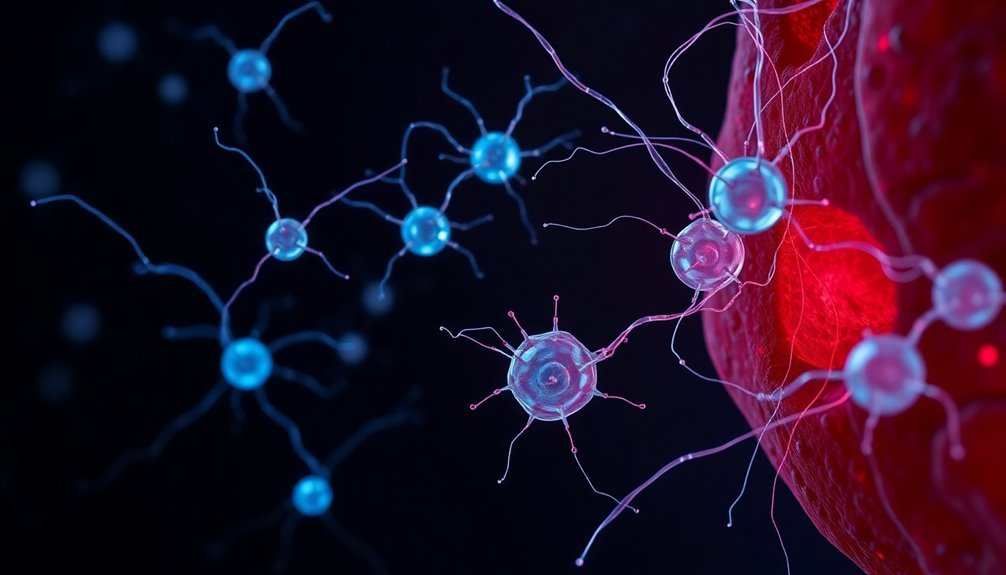



Leave a Reply